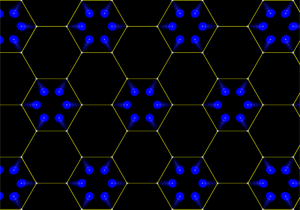In 2008, experiments were carried out at Columbia University that led to the receipt of pure graphene, a single layer of graphite with a thickness of a single atom, which has since become the strongest material known to mankind. This finding actually led to the question - how and why does graphene break?

In 2008, experiments were carried out at Columbia University that led to the receipt of pure graphene, a single layer of graphite with a thickness of a single atom, which has since become the strongest material known to mankind. This finding actually led to the question - how and why does graphene break?
Using quantum theory and supercomputers, researchers have been able to uncover the mechanisms leading to mechanical failure of pure graphene following tensile stress. In an article recently published in the scientific journal Physical Review Letters, the researchers showed that when graphene is exposed to equal stretching in all directions, it becomes a new structure that is mechanically unstable.
The researchers explain that this failure mechanism constitutes phonon instability in a soft form. A phonon is a common vibrational pattern of atoms within a crystal, similar to waves moving in a liquid. The fact that a phonon becomes "soft" under conditions of tensile stress means that the system can reduce its energy by deforming the atoms along the vibrational pattern and moving to a new crystalline arrangement. Under sufficient strain, graphene reaches a state where its honeycomb-like hexagonal arrangement is tilted toward disconnected hexagonal rings. This new crystal is structurally weaker, leading to mechanical failure of the graphene layer.
"Our findings are interesting in several respects," notes the researcher. "Soft forms of phonons were first identified in the sixties in the field of ferroelectric phase transition, but they were never directly attributed to the development of mechanical fracture. For the most part, defects in the material will always lead to premature failure, but the pure nature of graphene allows us to test our prediction. We have already planned a number of new interesting experiments in order to directly observe the results of the theoretical prediction of a soft form."
The lead researcher adds and explains that this is the first case ever that a soft optical phonon has been linked to a mechanical failure and therefore it is reasonable to assume that this innovative failure mechanism is not exclusive to graphene but may also be common in other thin materials. "As nanotechnology becomes increasingly common and widespread, understanding the nature of the mechanical behavior of two-dimensional systems, such as graphene, also becomes extremely important. We believe that stretching may be used as a tool to engineer the properties of graphene, and as a result, understanding its limits is essential."
More of the topic in Hayadan:

9 תגובות
The only reason for the weakness of graphene is that the material is a layer with a thickness of one atom and tensile or bending force cannot be spread over additional layers
Perhaps it would be useful to explain that an optical phonon is a wave that transmits motion within the unit cell, as opposed to an acoustic phonon that transmits motion between unit cells.
"which has since become the strongest substance known to mankind" end quote
And this is because the letter Aleph was omitted from the graphen=334 in gematria and they reversed it
To just graphen = 333 (Reference Isaiah chapter XNUMX verse XNUMX (see there above a vine in the sense of a vine or a vine in the sense of a vine if you can find it)
This is probably why carbon nanotubes that are closed graphene sheets are more durable. Because from a structural point of view, a situation of simultaneous attraction in all directions cannot be created, or at least this situation is not common due to the three-dimensional structure of the tubes.
This is probably also the reason why it took a while to discover the graphene.
what? If you stretch it, can it warp and even tear? Wow!! Amazing.
Thanks for the information in the body of the news (the explanation of the phonon is helpful and in place!)
Thanks for the information in the body of the news (the explanation about phonon)
As far as I know, an optical phonon is formed in a crystal of different types of atoms, while graphene is only made of carbon atoms.
I would love to get an explanation!
Aviloz